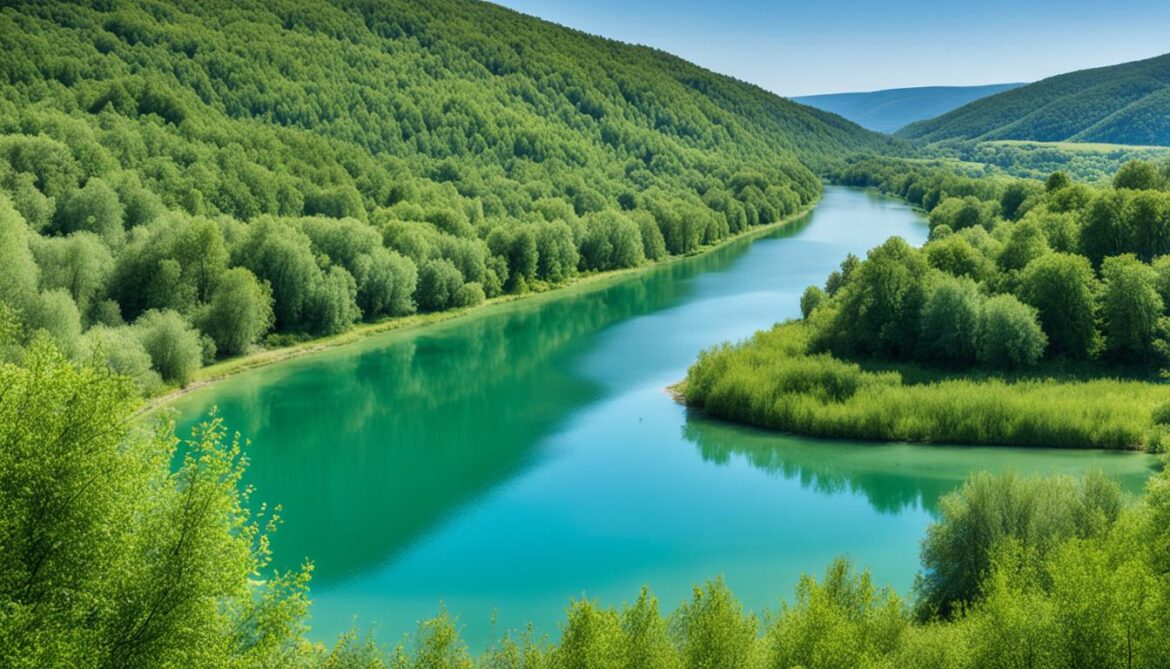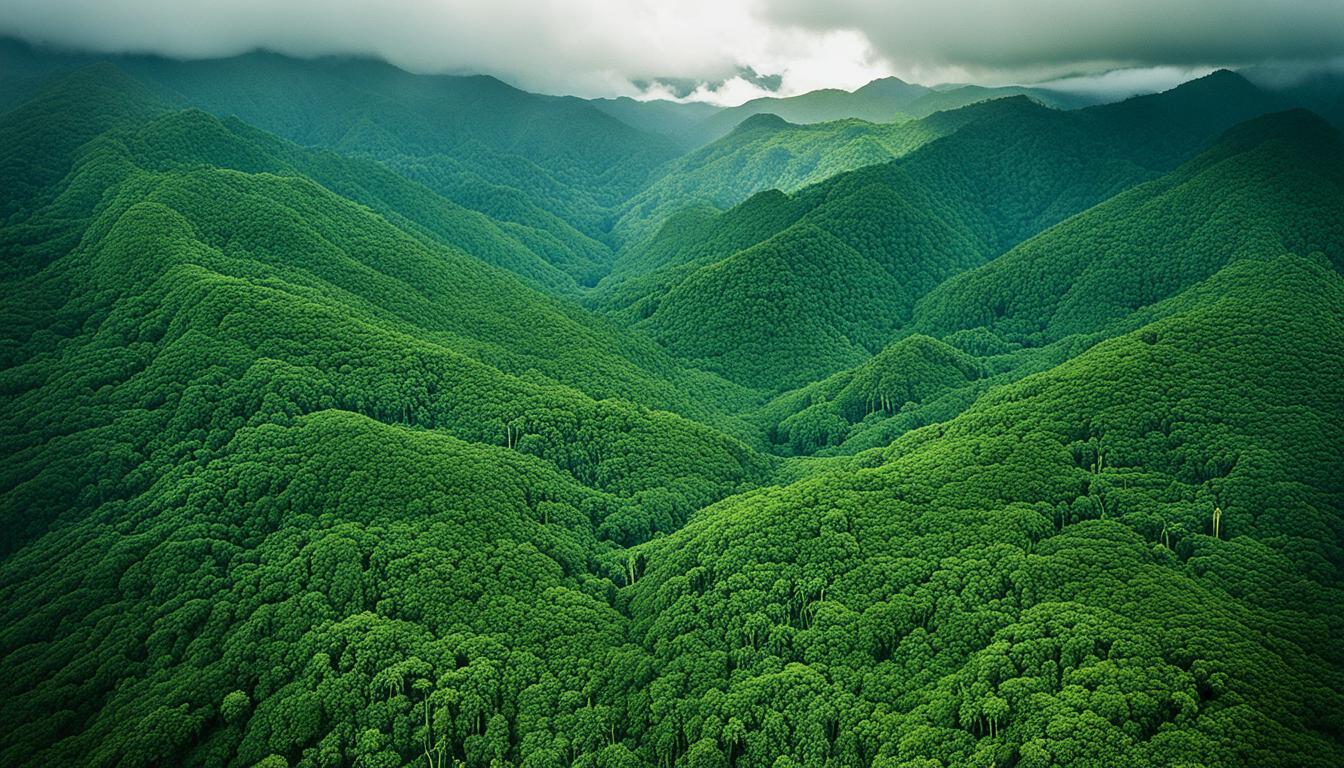Hungary Biodiversity: Animal and Plant Species and What Is Under Threat
Did you know that Hungary is home to more than 53,000 described species? With its rich biodiversity, this small European country boasts a diverse range of animal and plant life. However, this precious tapestry of nature is currently facing significant challenges.
Drastic changes in land use and agricultural practices have resulted in the loss of natural habitats and a decline in indigenous species. Forests, which cover 20.3% of Hungary’s territory, have seen an increase due to plantations, but non-native species now occupy a significant portion of these forests. Additionally, threatened habitats and endangered species face conservation status challenges. The situation calls for urgent action to protect and restore Hungary’s unique ecosystems.
In this article, we will explore the status of biodiversity in Hungary, the threats it faces, the endangered species, conservation efforts, and the importance of ecosystems such as grasslands and water bodies. Join us as we delve into the fascinating world of Hungary’s wildlife and the measures being taken to preserve it.
Key Takeaways:
- Hungary is home to over 53,000 described species, making it a biodiversity hotspot.
- Drastic changes in land use and agricultural practices have led to the loss of natural habitats and a decline in indigenous species.
- The conservation status of endangered habitats is considered bad, and 17% of evaluated species are endangered globally.
- Efforts are being made to protect endangered species, restore habitats, and promote sustainable practices in agriculture, forestry, and water management.
- Collaboration between different sectors and international cooperation are crucial to achieving biodiversity conservation goals in Hungary.
Biodiversity in Hungary: Status and Trends
Since the 1980s, Hungary has experienced significant changes in land use and agricultural practices, which have had a profound impact on its biodiversity. These changes have resulted in the loss of natural habitats and alterations in the composition of indigenous species populations.
Forests now cover 20.3% of Hungary’s territory, with indigenous tree stocks accounting for over 57% of this area. The preservation of forests and their ecosystems is vital for sustaining Hungary’s biodiversity and supporting various plant and animal species.
“Forests are the lungs of our land, purifying the air and giving fresh strength to our people.” – Franklin D. Roosevelt
Hungary’s commitment to conservation is evident through the establishment of protected areas, which make up 22% of the country’s land, surpassing the EU average. These protected areas play a crucial role in safeguarding important habitats and biodiversity hotspots.
The country is home to over 53,000 described species, including a wide array of plants, animals, and microorganisms. Among them, 3% are protected under national law to ensure their preservation and promote their flourishing in their natural habitats.
Despite conservation efforts, the conservation status of 67% of endangered habitats in Hungary is considered poor, indicating the urgent need for further action to protect these vital ecosystems. Additionally, 17% of evaluated species in Hungary are endangered globally, highlighting the global significance of Hungary’s conservation efforts.
Grasslands, covering 10.8% of Hungary’s territory, are of particular conservation importance. These diverse ecosystems provide habitats for a range of plant and animal species, and efforts are underway to monitor their populations and protect them from further decline.
Ecosystem Diversity in Hungary
Hungary boasts a rich variety of ecosystems, ranging from forests, wetlands, and meadows to rivers, lakes, and underground caves. Each of these ecosystems supports a distinct set of species, contributing to the overall biodiversity of the country.
- Forest Ecosystems: Forests play a critical role in Hungary’s biodiversity, providing habitats for numerous plant and animal species. They help maintain soil stability, regulate water flow, and sequester carbon, making them invaluable in mitigating climate change.
- Wetland Ecosystems: Hungary’s wetlands, including marshes, fens, and floodplains, are crucial for various bird species and water-dependent plants. These wetland habitats act as natural filters, purifying water and reducing the risk of floods.
- River and Lake Systems: Hungary is blessed with an extensive network of rivers and lakes, fostering diverse aquatic ecosystems. These water bodies support a multitude of fish, amphibians, and water birds, contributing to the country’s aquatic biodiversity.
- Meadows and Grasslands: Hungary’s meadows and grasslands are home to a plethora of wildflowers, grasses, and insects, hosting a vibrant mix of plant and animal life. These diverse grassland ecosystems are vital for the survival of many native species.
Trends in Biodiversity Conservation
To improve the status of biodiversity in Hungary, significant efforts are underway to monitor and manage species populations, protect endangered species, and restore habitats. Conservation organizations and governmental initiatives work hand-in-hand to implement measures that ensure the long-term sustainability of Hungary’s ecosystems.
- Natura 2000 Network: Hungary actively participates in the Natura 2000 network, a European initiative dedicated to conserving valuable habitats and species. This network safeguards critical areas and promotes international collaboration for biodiversity conservation.
- Captive Breeding Programs: Endangered species, such as the Hungarian meadow viper, are supported through captive breeding programs. These initiatives aim to increase the population of endangered species and reintroduce them into their natural habitats.
- Habitat Restoration: Efforts are being made to restore and rehabilitate degraded habitats, including forests, wetlands, and grasslands. Restoration programs aim to enhance biodiversity by bringing back native species and revitalizing ecosystems.
Monitoring and Research:
- Species Population Surveys: Regular monitoring and data collection are vital for assessing species populations and their conservation status in Hungary. These surveys provide valuable insights into population trends and guide targeted conservation efforts.
- Ecosystem Assessments: Comprehensive assessments are conducted to evaluate the health and functioning of different ecosystems in Hungary. These assessments help identify areas that require immediate attention and provide a basis for evidence-based conservation strategies.
| Habitat Type | Conservation Status |
|---|---|
| Forest | Significant conservation efforts are in place, but the conservation status of some forest habitats is poor, primarily due to non-native tree species. |
| Wetland | Wetland conservation is a priority, especially for migratory bird species and water-dependent plants. Restoration projects are underway to revitalize degraded wetland habitats. |
| River and Lake | Conservation efforts aim to improve water quality, reduce pollution, and safeguard the habitats of fish, amphibians, and water birds. |
| Meadow and Grassland | Grassland conservation is crucial to preserve the unique flora and fauna species that depend on these habitats. Sustainable land management and grazing practices are essential for maintaining grassland ecosystems. |
Protecting and conserving biodiversity in Hungary is a shared responsibility that requires the collaboration of individuals, communities, organizations, and governments. By valuing and safeguarding the remarkable diversity of species and ecosystems in Hungary, we can ensure a sustainable future for all.
Threats to Biodiversity in Hungary
Human activity poses the most significant threat to biodiversity in Hungary. As the country undergoes economic development, pressures on ecosystems have increased, resulting in the loss of biodiversity. Invasive alien species, habitat fragmentation, and climate change are key contributors to this decline.
The threats to biodiversity in Hungary are diverse and interrelated. From invasive alien species to habitat loss, these challenges require immediate attention and conservation efforts.
Monitoring data reveals that 5.5% of Hungary’s land is covered by perennial alien species, further exacerbating the biodiversity crisis. In particular, forests are under threat from various factors such as clear-cutting, dead wood removal, overpopulation of game animals, the spread of alien tree species, and difficulties in implementing conservation measures on privately-owned forests.
Moreover, Hungary’s geographical characteristics expose the country to negative transboundary environmental impacts. These impacts, coupled with the growing challenges of habitat loss, inadequate water supply, and pollution of water bodies, pose significant obstacles to biodiversity conservation in Hungary.
To paint a clearer picture of the threats to biodiversity in Hungary, refer to the table below:
| Threats to Biodiversity in Hungary | Brief Explanation |
|---|---|
| Invasive Alien Species | Ongoing proliferation of non-indigenous species negatively impacts native biodiversity. |
| Habitat Fragmentation | The division of natural habitats into smaller, isolated segments reduces biodiversity. |
| Climate Change | Altering climatic conditions disrupt ecological systems and threaten species survival. |
| Clear-cutting | The removal of trees without proper consideration for ecosystem balance and regeneration. |
| Dead Wood Removal | Eliminating dead wood disrupts the natural decay process, impacting several species dependent on this resource. |
| Overpopulation of Game Animals | Uncontrolled growth in animal populations can lead to imbalances in ecosystems. |
| Spread of Alien Tree Species | Non-native tree species compete with indigenous species and may dominate ecosystems. |
| Difficulties in Conservation Measures on Privately-owned Forests | Challenges in implementing conservation efforts due to the ownership structure of forests. |
| Negative Transboundary Environmental Impacts | Hungary’s location exposes it to adverse environmental effects from neighboring countries. |
| Habitat Loss | The destruction and fragmentation of habitats reduce the availability of suitable environments for species. |
| Inadequate Water Supply | The scarcity of water resources threatens the survival of aquatic species and impacts terrestrial ecosystems. |
| Pollution of Water Bodies | Contamination of rivers, lakes, and other water bodies negatively impacts aquatic biodiversity. |
Together, these threats challenge comprehensive biodiversity conservation in Hungary and necessitate the implementation of effective measures to protect its diverse ecosystems and species.

By addressing these threats and working towards sustainable practices, Hungary can secure the future conservation of its unique biodiversity.
Endangered Species in Hungary
Hungary is a country that houses a diverse range of animal and plant species. Unfortunately, several of these species are currently facing the threat of extinction. According to a 2008 assessment, 17% of evaluated species in Hungary are endangered on a global scale. Additionally, 27.5% of vascular plant species evaluated in 2007 were found to be in danger. Ongoing monitoring of 211 animal and plant species of European importance has revealed that 32% of their populations are decreasing.
One of the most endangered vertebrate species in Hungary is the Hungarian meadow viper (Vipera ursinii rakosiensis). To help conserve its population, a captive breeding program has been implemented. Another endangered species that has shown promising growth is the Great Bustard (Otis tarda), with its population nearly doubling since the early 1990s. Additionally, the Imperial Eagle (Aquila heliaca) has seen an increase in its population from 20 breeding pairs in the 1980s to over 90.
Efforts are underway to monitor and protect these endangered species and their habitats in Hungary. Conservation organizations and authorities work together to implement measures that safeguard these vulnerable populations. Through targeted monitoring, habitat restoration, and protection initiatives, Hungary strives to ensure the survival and thriving of its endangered species.
Endangered Species in Hungary:
| Species | Status |
|---|---|
| Hungarian Meadow Viper (Vipera ursinii rakosiensis) | Endangered |
| Great Bustard (Otis tarda) | Endangered |
| Imperial Eagle (Aquila heliaca) | Endangered |

These are just a few examples of the endangered species found in Hungary. The conservation efforts put in place aim to protect and preserve the unique biodiversity of the country, ensuring a sustainable future for its ecosystems.
Conservation Efforts in Hungary
Hungary has implemented various conservation efforts to protect its biodiversity. The total amount of territory under protection has increased from 9.4% to 22%, exceeding the EU average. The establishment of protected areas and the enhancement of the Natura 2000 network have played a vital role in conserving important habitats and species.
Strict measures have been put in place to protect endangered species and their habitats, including captive breeding programs and reintroduction initiatives. Monitoring and research efforts are ongoing to assess the conservation status of species and habitats. Collaboration with neighboring countries, such as Slovakia, has also been instrumental in conserving large carnivores and ensuring their genetic diversity.
These conservation efforts aim to preserve Hungary’s unique biodiversity and create a sustainable future for its ecosystems. By prioritizing biodiversity conservation, Hungary can protect its natural heritage and contribute to global efforts in environmental protection.
Importance of Grasslands in Hungary
Grasslands in Hungary play a crucial role in biodiversity conservation. Covering 10.8% of the country’s territory, they are an integral part of Hungary’s natural heritage. These grasslands are highly diverse, surpassing the biodiversity found in many other countries.
Most of the grasslands in Hungary are secondary grasslands, formed as a result of human activity over centuries. Extensive grazing by livestock, such as cows and sheep, is necessary for the maintenance of these grasslands. Grazing helps control the growth of woody plants and allows the persistence of diverse grass and herb species that thrive in open, sunny conditions.
These grasslands provide vital habitats for a wide variety of plant and animal species. They support numerous endemic species, unique to Hungary, found nowhere else in the world. Furthermore, grasslands offer refuge to several endangered species, including the Hungarian meadow viper (Vipera ursinii rakosiensis).
“Hungarian grasslands are rich in biodiversity, harboring a vast array of plant and animal life. They are essential ecological landscapes that contribute significantly to the conservation of Hungary’s unique species.”
Endemic Species of Hungarian Grasslands
The Hungarian meadow viper (Vipera ursinii rakosiensis) is a critically endangered snake species found exclusively in Hungary’s grasslands. Conservation efforts are being made to protect this iconic species and its fragmented habitats.
In addition to the Hungarian meadow viper, other endemic species that rely on grassland ecosystems include plants like the Hungarian sainfoin (Onobrychis humilis) and animals such as the Hungarian short-horned grasshopper (Calliptamus abbreviatus).
Conservation of Grassland Ecosystems
Recognizing the ecological importance of grasslands, efforts are being made to restore and maintain these unique ecosystems. Several conservation initiatives focus on promoting extensive grazing practices, which mimic the natural processes that have shaped grasslands over centuries.
Furthermore, protection measures are in place to preserve the endangered species that depend on these habitats. The Hungarian grasslands are included in the Natura 2000 network, a network of protected areas aimed at safeguarding Europe’s most valuable and threatened habitats and species.

| Endemic Species | Conservation Status |
|---|---|
| Hungarian meadow viper (Vipera ursinii rakosiensis) | Critically endangered |
| Hungarian sainfoin (Onobrychis humilis) | Endangered |
| Hungarian short-horned grasshopper (Calliptamus abbreviatus) | Vulnerable |
Conservation efforts are essential to ensure the long-term survival of these species and protect the unique biodiversity found in Hungarian grasslands. By preserving these diverse ecosystems, Hungary can safeguard its natural heritage and contribute to global biodiversity conservation.
Water Bodies and Biodiversity in Hungary
Hungary boasts a wide variety of water bodies, including natural lakes, rivers, and artificial fishponds. These aquatic ecosystems serve as important habitats for numerous species and contribute significantly to the country’s overall biodiversity. However, these precious water bodies face several challenges that threaten their health and the wildlife they support.
Nutrient Pollution and Freshwater Bodies
Approximately 56% of Hungary’s freshwater surface bodies are at risk due to organic and nutrient pollution. This can have detrimental effects on water quality and disrupt aquatic ecosystems. Contaminated water bodies can experience algal blooms and reduced oxygen levels, leading to the decline of fish and other aquatic species.
Artificial Lakes and Fishponds
About 70% of Hungary’s artificial lakes, primarily fishponds, are also at risk. These fishponds play a crucial role in supporting both commercial and recreational fishing activities. However, pollution and habitat degradation in these water bodies can have significant negative impacts on fish populations and the surrounding biodiversity.
Groundwater Sources
While overall Hungary’s groundwater bodies are not considered at risk, some locations are labelled as “possibly at risk” due to nitrate pollution. Appropriate management and monitoring are crucial in safeguarding the quality of these underground water sources to ensure the well-being of dependent ecosystems.

Conservation and Protection Efforts
Efforts are being made to improve water quality, reduce pollution, and protect Hungary’s vital water ecosystems. Collaborative initiatives involving government agencies, conservation organizations, and local communities aim to implement water management strategies that prioritize biodiversity conservation.
These initiatives include:
- The implementation of wastewater treatment plants to reduce organic and nutrient pollution
- Regulations and policies to control agricultural runoff and limit the use of harmful pesticides and fertilizers
- Monitoring programs to assess water quality and identify areas that require conservation interventions
- Habitat restoration projects to enhance the health and diversity of aquatic ecosystems
By prioritizing the protection and conservation of water bodies, Hungary can ensure the preservation of its unique aquatic biodiversity and contribute to the overall sustainability of its ecosystems.
The Role of Agriculture in Biodiversity Conservation
Agriculture plays a crucial role in shaping the biodiversity of Hungary, as it occupies 62.4% of the country’s territory. However, changes in land use and intensive farming practices have led to the loss of natural habitats and a decline in biodiversity.
Efforts are now underway to promote sustainable agricultural practices that prioritize biodiversity conservation. Organic farming, for example, reduces the use of synthetic chemicals and aims to protect soil health, water resources, and wildlife habitats. Adopting soil and water-saving technologies can help minimize the negative impact of farming on the environment.
“By choosing organic farming methods, we can ensure the preservation of genetic resources and the long-term sustainability of agricultural ecosystems,” says Dr. István Nagy, Hungary’s Minister of Agriculture.
Another important aspect of preserving biodiversity in agriculture is the establishment of buffer zones. These areas act as protective barriers between sensitive ecosystems and agricultural activities, preventing the contamination of natural habitats and allowing species to thrive.
Moreover, promoting landscape diversity within agricultural landscapes contributes to enhancing biodiversity. By creating different habitats within farmlands, such as hedgerows, ponds, and flower strips, farmers can attract a variety of beneficial insects, birds, and other wildlife.
Collaboration between the agricultural sector and biodiversity conservation initiatives is vital to achieving a harmonious balance between agricultural production and the preservation of biodiversity. By working together, we can ensure that Hungary’s agricultural practices are sustainable and align with nature conservation goals.
Benefits of Sustainable Agriculture:
- Protection of genetic resources
- Preservation of soil health
- Conservation of water resources
- Enhancement of wildlife habitats
- Promotion of ecosystem resilience
- Reduction of synthetic chemical usage
Collaboration Examples:
In Hungary, organizations such as the Hungarian National Rural Network and the European Agricultural Fund for Rural Development provide support and funding for sustainable agriculture practices. Additionally, partnerships between farmers, environmental NGOs, and government agencies facilitate the exchange of knowledge and the implementation of conservation measures.

Case Study: Landscape Diversity in Wheat Fields
One successful example of promoting landscape diversity in agricultural settings is incorporating flower strips in wheat fields. These strips consist of a variety of colorful flowers, providing food and shelter for beneficial insects, such as bees and butterflies. By attracting these pollinators, farmers can enhance crop yield and promote biodiversity within their fields.
| Flower Strips Benefits | Conservation Gains |
|---|---|
| Increased pollination | Enhanced crop productivity |
| Improved pest control | Reduced need for pesticides |
| Attracting beneficial insects | Enhanced biodiversity on farmlands |
| Visual enhancement | Improved aesthetics of agricultural landscapes |
By implementing these innovative approaches and encouraging collaboration, agriculture and biodiversity conservation can go hand in hand, ensuring a sustainable and thriving future for Hungary’s ecosystems.
Forest Management for Biodiversity Conservation
Forests play a vital role in biodiversity conservation in Hungary, covering 20.3% of the country’s territory. The management practices employed in these forests have a significant impact on the conservation of forest species and habitats.
Efforts are being made to promote natural forest management approaches that maintain continuous forest cover and preserve the diversity of forests. By prioritizing the preservation of indigenous species, non-native tree species and forests that do not suit the given habitat are being converted.
Buffer zones are being established around sensitive habitats to ensure their protection. Additionally, measures are being implemented to reduce clear-cutting and enhance the regeneration of forests. These strategies aim to maintain the ecological balance and prevent the loss of valuable forest resources.
Forest management is not only crucial for protecting biodiversity but also for securing water and food sources for game animals. By managing forests sustainably, the impact on both forested and agricultural lands can be minimized.
Conservation Strategies for Forest Management:
- Promote natural forest management approaches to maintain continuous forest cover and preserve diversity.
- Convert non-native tree species and forests that do not suit the given habitat.
- Establish buffer zones around sensitive habitats.
- Implement measures to reduce clear-cutting.
- Enhance forest regeneration.
The Importance of Forest Management for Biodiversity Conservation:
Forests are not only home to numerous plant and animal species but also provide essential ecosystem services. By properly managing forests, their biodiversity can be conserved, ensuring the long-term sustainability of ecosystems in Hungary.
Forest management practices in Hungary are evolving to create a harmonious balance between resource utilization and conservation. Through these efforts, Hungary aims to protect its unique forest ecosystems and contribute to global biodiversity conservation.

Conservation and Sustainable Water Management
Water resources and their management play a crucial role in biodiversity conservation in Hungary. Efforts are being made to restore the water storage capabilities of wetland habitats, control the use of surface and underground water resources, and improve water quality in lakes and rivers. Restoration of wetlands and flood-prone areas is important to increase the habitat for water-dependent species.
Proper water management practices, including ecological flood management, will ensure the sustainability of water resources and promote biodiversity conservation. Collaboration between water management authorities and biodiversity conservation initiatives is essential to achieve these conservation goals.

| Water Management Challenges in Hungary | Conservation Measures |
|---|---|
| Poor water storage capabilities of wetland habitats | Restoration of wetlands to enhance habitat availability for water-dependent species |
| Uncontrolled use of surface and underground water resources | Implementation of effective water resource management strategies |
| Pollution and poor water quality in lakes and rivers | Measures to improve water quality and reduce pollution levels |
| Loss of flood-prone areas | Restoration of flood-prone areas to create habitats for water-dependent species |
By addressing these water management challenges and implementing sustainable practices, Hungary can ensure the long-term preservation of its water resources and the protection of its diverse ecosystems and species.
Conclusion
Protecting and conserving biodiversity in Hungary is crucial for maintaining the ecological balance and ensuring the long-term sustainability of ecosystems. The country’s diverse range of plant and animal species face numerous threats from human activity, such as changes in land use, invasive alien species, and habitat loss. However, Hungary is actively involved in significant conservation efforts to address these challenges.
Monitoring species populations, protecting endangered species, restoring habitats, and promoting sustainable practices in agriculture and forestry are key components of these conservation initiatives. By collaborating across different sectors and engaging in international cooperation, Hungary strives to achieve its conservation goals and secure a future where its unique ecosystems and species can thrive.
Through prioritizing biodiversity conservation, Hungary takes a proactive stand in preserving its natural heritage and safeguarding the delicate balance of its ecosystems. By valuing and protecting its rich tapestry of plant and animal species, Hungary enhances the resilience of its environment and ensures the long-term sustainability of its natural resources. Only through collective efforts and a shared commitment to environmental stewardship can the country forge a path towards a thriving and ecologically sound future.








